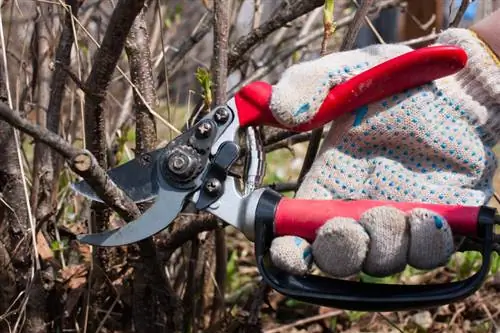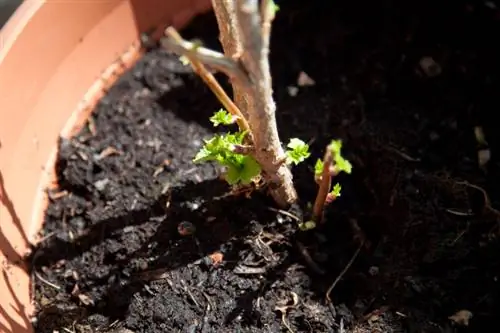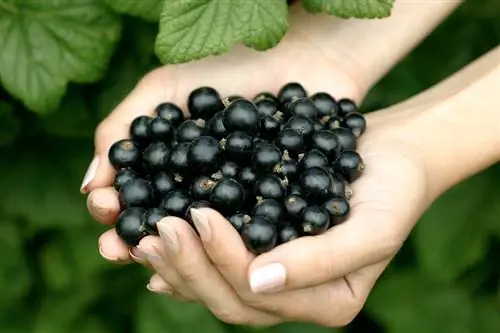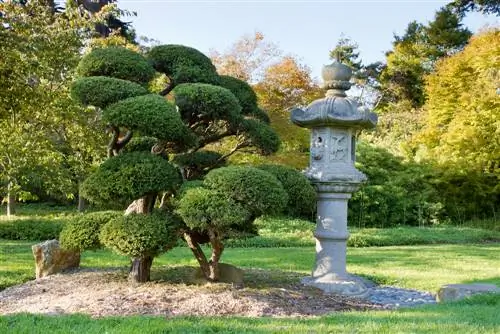- Author admin [email protected].
- Public 2023-12-16 16:46.
- Last modified 2025-06-01 06:02.
Currants are one of the busiest sources of fruit in the home garden. You can significantly improve fruit quality and harvest yield with expert pruning. Red and white currants are blended differently than black varieties. In this tutorial you will read when and how to properly cut currant bushes.
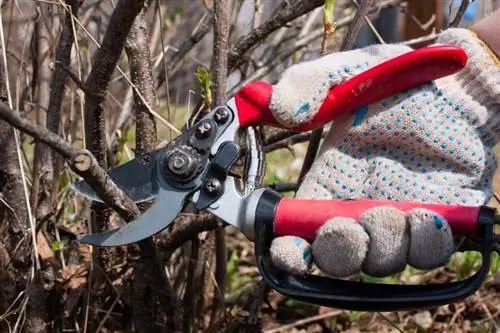
How should you cut currants?
Cut currants after planting in autumn and remove weak shoots. Shorten five to seven ground shoots in spring. Make the cut over the outward-facing bud. The optimal distance is two to three millimeters.
Cutting currants - cutting types and dates
Red and white currantsbear the best fruit on theone-year-old side shoots of two- and three-year-old ground shootsThe yield drops by the fourth year at the latest visibly after. Blackcurrantsfruit excellently onannual long shoots In both cases, pruning care aims to promote fruit wood and continuous rejuvenation through thinning. The following table provides an overview of all types of cuts with recommended dates:
| Cut style | Goal/Occasion | best date | alternative date |
|---|---|---|---|
| Planting and training pruning | advantageous structure, growth promotion | in spring 1st and 2nd year | none |
| Pruning red and white currants | Promote fruit wood, thin out old wood | from the 3rd year after the harvest | from the 4th year in spring |
| Pruning Blackcurrants | Promote annual long shoots, remove old wood | from the 3rd year in spring | none |
| Rejuvenation cut | revitalize aged currants | late winter | none |
| Topiary tree trunk | Crown blending productively | after harvest | in early spring |
Central cutting dates for currants are in midsummer or early spring. Please pay attention to suitable weather conditions on the day itself. On scorching hot, bone-dry summer days, please spare your shrubs the stress of pruning. Atmild temperatures and overcast skies all trees respond more favorably to pruning measures. The same applies to bitterly cold winter days with temperatures below freezing.
Planting and training pruning - step-by-step instructions
All currants benefit from planting and training pruning. A light pruning on the day of planting is the prologue. In the spring of the first two years of growth, you show a berry bush the way to productive growth. For this purpose, the number of ground shoots that support the fruit wood is limited. This is how you complete pruning care with expertise:
- After planting in autumn, cut out damaged, noticeably weak shoots
- The following spring, select the best five to seven ground shoots and cut them back by a third
- Make the cut above aoutward-facing bud at an ideal distance of 2 to 3 mm
- Remove all remaining ground shoots
- In the 2nd year, cut back theprevious year's growth by half on the scaffold shoots
- Carry out the pruning again on buds
- Tighten out excess, weak ground shoots
The number of suitable ground shoots for growing a shrub depends, among other things, on the space available. If a currant bush can develop freely, leave up to twelve strong ground shoots as a framework. A number exceeding this poses the risk of too dense growth, which significantly affects the crop yield.
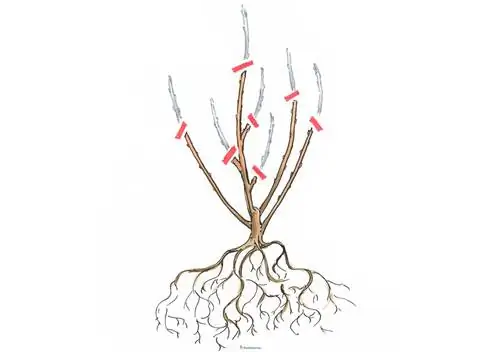
Freshly planted currants should be cut back by a third in order to encourage budding and build an optimal structure. A currant bush is well positioned with five to seven strong ground shoots. All remaining ground shoots are removed.
Background
Plant pruning - wake-up call for unwilling buds
It is difficult for any gardener to immediately trim a freshly planted currant by at least a third. If you later want to indulge in hordes of juicy berries, you should still get around to cutting the plants. The reason for the urgent recommendation is a targeted redirection of the juice pressure to deeper buds. The growth law of top promotion teaches that a berry bush uses all its strength to transport its reserve substances into its top buds in order to grow upwards as quickly as possible. Deeper buds do not sprout and roots grow weakly because they lack juice and strength. By cutting off buds at the top positions, the sap flow is redirected to the neglected buds. This is where lively shoots begin, which are beneficial for rooting and provide you with valuable fruit wood.
Red and white currants - maintenance pruning
Starting in the summer of the third year, the education phase leads to the maintenance phase. For red and white currants, the focus is on two goals: continuous rejuvenation and promotion of one-year-old side shoots on two- to three-year-old scaffold shoots. Four-year-old and older ground shoots decline significantly, so they are removed in good time to make room for new scaffold shoots. The valuable fruit wood sprouts along the two- and three-year-old ground shoots, which should not crowd each other too much. This is how a maintenance cut goes perfectly:
- The best time is after the harvest, alternatively the following spring
- At the beginning, cut off 3 older scaffold shoots (dark brown bark) at the base
- In return, leave the 3 most promising, young ground shoots (light brown bark) uncut
- Remove excess shoots from the rootstock
- Cut side shoots harvested from remaining scaffold shoots back to 1-2 cm short stubs
- This year's light brown branches as future fruit wooddo not cut
Finally, focus on the fine-tuning of the conservation cut. First, remove all side branches up to a height of 30 centimeters. Side branches close to the ground are irrelevant for fruit formation because there is a lack of light at this point. In principle, do not subject this year's growth to any cutting. An exception applies if the young side shoots thrive close to the scaffold shoot, with a distance of less than 10 centimeters. Cut every second side shoot to a short stub.
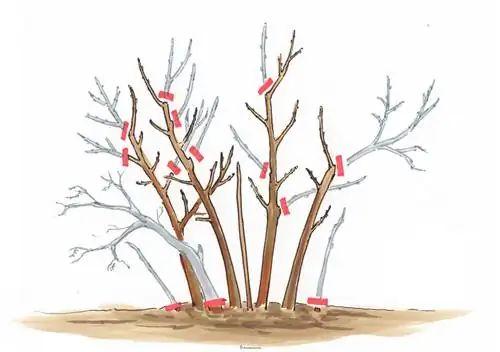
From the third year onwards, thin out three old ground shoots in exchange for young wood. There should not be more than eight to twelve scaffolding shoots that are one to four years old. Cut off side shoots close to the ground. Shorten worn fruit wood to short stubs.
Excursus
Immediately remove wild shoots from high stems
Currants thrive as standard trees in small gardens or on the balcony. This is a high-yielding noble variety that was grafted onto the trunk of a wild rootstock by the hand of the master gardener. Sometimes the wild rootstock draws attention to itself by sprouting lots of shoots from the rhizome or trunk. No flowers or tasty fruits can be expected from such shoots. Rather, so-called water shoots compete with the noble currant for nutrients, water and light. Remove wild shoots as quickly as possible. Simply tear off the cheeky branches from the rootstock. Cut off blind shoots along the trunk just before the bark without damaging it.
Cutting blackcurrants
Black currants receive a noticeably stronger maintenance cut than their red-fruited counterparts. The reason for the rigorous cutting is the valuable fruit wood in the form of annual long shoots. As the illustration below illustrates, annual long shoots are not a case for secateurs. The continuous rejuvenation, similar to red currants, rounds off the maintenance pruning. How to cut blackcurrants correctly from the third year onwards:
- Best time is in spring
- At the beginning thin out some older scaffold shoots
- Leave young, strong ground shoots as a replacement and do not cut them
- Remove remaining ground shoots without long stubs
- Cut back the remaining main branches to just above the second or third lateral long shoot
- Cut back worn long shoots to 2 cm short cones
Measure the number of main branches based on light-flooded growth. Act according to the rule of thumb: a few, well-lit ground shoots with annual long shoots produce the larger and juicier currants.
You have done everything right if, after cutting, your blackcurrant has up to twelve ground shoots that only bear long annual shoots.

One-year-old long shoots are spared from the scissors during maintenance pruning. These are easily recognizable by their light brown bark. Three older scaffold shoots are replaced by young ground shoots. Cut any remaining scaffold shoots back to the second or third long side shoot.
Tip
A brand of secateurs is perfect for pruning one- to three-year-old branches. One-handed pruning shears can no longer be used to thin out old ground shoots on currants. You can easily prune thick fruit branches with a handy folding saw or two-handed pruning shears.
Rejuvenate old currants
A well-cared for currant cannot do without annual pruning. Within a few years, neglected berry bushes grew old into impenetrable bushes with sparse fruit. That is no reason to undertake the effort of deforestation. If you subject the bush to expert rejuvenation pruning, there are good prospects of a new beginning full of berries. How to proceed correctly step by step:
- The best time is in late winter (good for the shrub and compliant with the Federal Nature Conservation Act)
- Saw dead, outdated scaffolding shoots at ground level
- If available, leave young, light brown ground shoots unpruned for new growth
As the illustration below shows, do not thin out old ground shoots if they have at least one young side branch to offer. Here the pruning shears are placed just above the young wood, which takes on the function of the new main branch.
Ideally, you can use new ground shoots and a few light brown side branches on old main branches. If both conditions are not met, the currant no longer has the courage to live and should be cleared.
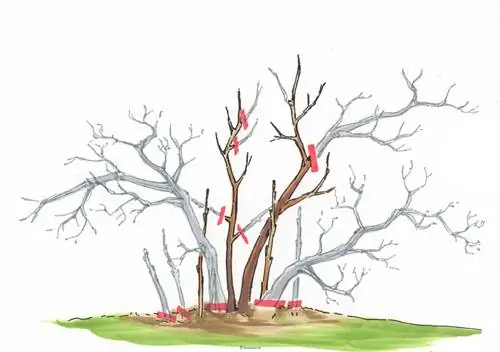
Without regular pruning, outdated, dark brown wood dominates the currant bush. Cut off all old shoots at ground level. Young shoots with light brown bark are left as replacements. Old scaffold shoots with young side shoots are rejuvenated by a derivation cut.
Background
Cutting clears the way for young fruit wood
In the expert pruning care of currants, the focus is on a regular generation change between young and older shoots. If the gardener is familiar with the drainage cut, the cut is very easy. To rejuvenate a worn, senescent ground shoot, look for a young, light brown side shoot at the bottom. Where dark brown, old wood and young, light brown wood fork, scissors or saws come into play. The cut is made into the old wood a few millimeters behind the fork so as not to damage the fresh fruit wood.
Topiary cutting on the tall trunk
Popular currants thrive as decorative standard stems with richly branched crowns. An annual topiary is aimed at light-flooded growth and a harmonious, productive crown. The best time isafter the harvest In contrast to red and white varieties, blackcurrant standard stems should be trimmed more heavily. The following instructions get to the heart of the details:
Red and white currants
- Ideal crown with central shoot and 4 evenly distributed leading branches in a diagonal-horizontal growth direction
- Cut back leading branches to a maximum length of 30 centimeters
- Shorten worn fruit wood to short cones
- Remove all side shoots of the leading branches that are 5 cm or less away from the central shoot/trunk
- Each year thin out one or two older leading branches in exchange for young scaffolding shoots
Blackcurrants
- Ideal crown with central shoot and 6 evenly arranged leading branches
- After harvesting, divert all leading branches to a young side shoot further inward
- Two-year-old side branches on the crown structure are cut back to 2 cm short cones
- Cut out weak shoots that grow into the interior of the crown or steeply upright
After making a cut, please check the support post carefully. Standard berry stems are at risk of breakage, particularly at the processing point. This is especially true when the crown has to bear its sweet burden. A solid support made of hardwood prevents the mishap. Tie the crown once and the stem to the post at least twice.
Frequently asked questions
Are currants self-fruitful?
All currants are naturally self-fruitful. The harvest yield is of course much more productive if you add at least a second variety. There are no limits when it comes to variety selection. If you love variety, mix white, red and black currants.
Two years ago I planted red and black currants as stems. This year the yield is noticeably decreasing. What can you do to continue to achieve good crop yields?
Thin out the crowns every year in late summer by cutting out some of the older, thick shoots at the base. An airy, loose crown is important so that currants can get enough sun to ripen. Apply a special berry fertilizer with a balanced nitrogen-phosphorus ratio. Nitrogen-rich complete fertilizers promote the growth of leaves, which is at the expense of flowers and berries. Regular watering is important because buds and flowers drizzle in dry conditions. Cover the ground with bark mulch or plant ground cover under planting.
Are currants suitable for growing in containers? If so, how big should the pot be at least?
It is possible to keep currants in pots as long as the water and nutrient supply is ensured. For optimal fertilization, we recommend planting at least two different varieties in close proximity and in your own pot. A pot should have a volume of at least 15 liters, preferably more. In a sunny location, the substrate dries out quickly, which can lead to fruit drop. The more potting soil surrounds a berry bush, the lower the risk of drought stress.
Numerous fruits on my blackcurrant turn brown and soft every year. What are the causes? Can I do something about it?
Characteristic of currants is their pronounced sensitivity to dryness during fruit ripening. If the soil dries out, premature fruit drop occurs. Before this happens, the berries turn brown and soften. As a preventive measure, please ensure that the soil is continuously moist. Thin the shrub once a year to allow air to circulate and sunlight to fall on the flowers and fruit. Check daily with a thumb test whether the soil on the surface has dried out and whether watering is necessary.
Should I trim a blackcurrant after planting in the same way as red or white varieties?
Moderate pruning after planting is advisable. However, do not cut too deeply into the wood so close to winter, otherwise frost could cause greater damage. A light plant pruning in autumn supports root formation and strengthens buds in the lower parts of the plant. Only in spring do you prune all shoots by a third or half to get the branching going.
When and how should a standard tree be blended with red currants?
After harvesting, thin out the crown thoroughly. Cut off dead wood, crosswise or inward-facing shoots. Shorten the removed side branches of the main branches to short cones so that they sprout and bear fruit the summer after next. In the interests of continuous rejuvenation, we recommend regularly removing the thickest, oldest shoots completely so that he althy, young wood can develop. If the branching on the main branches leaves something to be desired, revive the shoots by cutting them back by a third or half. Cut just above a bud aimed at the outer crown area.
The 3 most common cutting mistakes
The disappointment is great when fresh, home-grown currants are rare in summer. Bare, senescent berry bushes with poor yields are the result of classic pruning errors. The following table lists the three most common mistakes when cutting currants, names typical damage patterns and gives valuable tips for prevention:
| Cutting errors | malicious image | Prevention |
|---|---|---|
| never photographed | densely branched bushes with a few currants in the outer area | thin out some of the oldest ground shoots every year |
| young shoots cut back heavily | low crop yield | do not prune light brown young shoots |
| no plant cutting | poor branching, little fruit wood | After planting, cut all shoots by a third |
Home gardeners make another mistake when cutting currants in advance. Due to lack of time or because it is simply annoying, scissor blades and saw blades are not cleaned before cutting. The result is an unbridled spread of diseases and pests via infected cutting tools. Please clean the scissors and saw with hot water before each use. Additionally disinfect the cutting edges with alcohol, cleaning spirits or Sagrotan.

Tip
Sprinkling is a common phenomenon on grape vines, which also affects currants. Late frosts, extreme drought or cold in the middle of the flowering period cause buds and flowers to drop. Make sure the soil moisture is consistent throughout the season. If meteorologists announce delayed ground frosts, protect your berry bushes overnight with a warming fleece cover.

